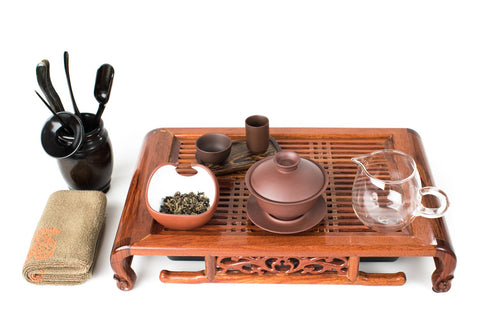Gong Fu Tea Brewing vs Western Brewing

How To Brew Tea Western Style
• Prepare a teapot.
• Place the appropriate amount of tea leaves inside. (We recommend using between 1 to 1.5 grams of tea per every 100ml of water)
• Brew the tea using the right water temperature.
• After 3 to 5 minutes, remove the tea leaves to prevent over-brewing (for this purpose, we recommend using a teapot with a strainer).
• Pour the tea into your teacups and enjoy!
Video on how to brew tea Western-style
Gong Fu differs from the Western way of brewing in that it allows for the tea to open to its full potential gradually.While ‘Gong Fu’ or the Chinese tea ceremony may look complicated and tedious for the first timers, in reality, it is not as difficult as it seems. Anyone can learn how to brew tea Gong Fu style and you do not have to be a tea master to do it. It’s very likely that after trying it once for yourself, it might just become a habit!

How To Make Gong Fu Tea
• Preheat the teapot by first pouring hot water inside.
• Empty the vessel. Place the tea leaves inside and let them warm up for a minute. (Amount of tea used will differ depending on the tea type).
• You will notice the change in the aroma as the tea leaves start slowly opening up.
• Quickly rinse the tea first before brewing (depending on tea type).
• Start brewing your tea: decant all the tea each time after only a few seconds of steeping. Start from 5-10 seconds at first and keep increasing the brewing time in a few seconds increments as you continue steeping. (Steeping times will differ depending on the tea type).
• Look at the color of the liquid, inhale the aroma, sip slowly, and you will feel how the tea is gradually changing.
Notice how, with each infusion, the flavor transforms - some more robust, some sweeter, some delicate.
Video on how to brew tea Gong Fu style
 By brewing Gong Fu style, we get the most out of our tea. 5-10 infusions from most teas; others even more than that. It doesn’t have to be every day. Even if you find just one day a week to enjoy Gong Fu Cha, it is well worth the effort.
By brewing Gong Fu style, we get the most out of our tea. 5-10 infusions from most teas; others even more than that. It doesn’t have to be every day. Even if you find just one day a week to enjoy Gong Fu Cha, it is well worth the effort.